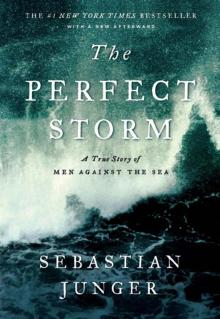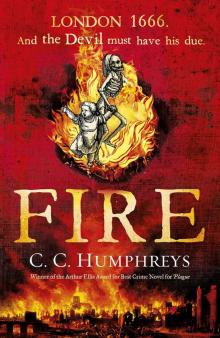- Home
- Sebastian Junger
Fire Page 6
Fire Read online
Page 6
There were many other fire fighters on Storm King when Brad Haugh crested the ridge, yet he feared that he and the two men with him were the only ones on the mountain left alive. That thought—not the flames—caused him to panic. He ran blindly and nearly knocked himself unconscious against a tree. Fires were spotting all around him as the front of flames chased him. The roar was deafening; “a tornado on fire” was how he later described it. The light, he remembered, was a weird blood-red that fascinated him even as he ran.
The two smoke jumpers with him were Eric Hipke and Kevin Erickson. Hipke had been so badly burned the flesh was hanging off his hands in strips. Haugh paused briefly to collect himself, then led the two men about a hundred yards down the mountain, stopping only long enough to wrap Hipke’s hands in wet T-shirts. As they started down again, the fire was spreading behind them at a thousand acres an hour, oak, pinyon, and juniper spontaneously combusting in the heat.
“I didn’t have any nightmares about it later,” said Haugh. “But I did keep waking up in the night very disoriented. Once I had to ask my girlfriend who she was.”
The South Canyon fire, as it was called, ignited on Saturday, July 2, as a lightning strike in the steep hills outside Glenwood Springs. At first people paid it little mind because dry lightning had already triggered thirty or forty fires across the drought-plagued state that day; another wisp of smoke was no big deal. But this blaze continued to grow, prompting the Bureau of Land Management (BLM) district office in Grand Junction to dispatch a seven-member crew on the morning of July 5 to prepare a helicopter landing site, designated H-1, and start cutting a fire line along a ridge of Storm King. At this point the blaze was cooking slowly through the sparse pinyon and juniper covering the steep drainage below. Glenwood Springs was visible to the east, and a pricey development called Canyon Creek Estates was a mile to the west. Interstate 70 followed the Colorado River one thousand feet below, and occasionally the fire fighters could see rafters in brightly colored life jackets bumping through the rapids.
The BLM crew worked all day, until chain saw problems forced them to hike down to make repairs. Replacing them were eight smoke jumpers from Idaho and Montana (eight more would be added the next morning) who parachuted onto the ridgetop to continue cutting fire line. They worked until midnight and then claimed a few hours’ sleep on the rocky ground.
Just before dawn, on the morning of July 6, Incident Commander Butch Blanco led the BLM crew back up the steep slope. Arriving at the top, Blanco discussed strategy with the smoke jumper in charge, Don Mackey. At about the same time, the BLM office in Grand Junction dispatched one additional crew to the fire, the twenty-member Prineville Hotshots, a crack interagency unit from Oregon whose helmet emblem is a coyote dancing over orange flame.
The smoke jumpers had cleared another landing spot, H-2, on the main ridge, and around twelve-thirty in the afternoon, a transport helicopter settled onto it. The first contingent of the Prineville crew ran through the rotor wash and crouched behind rocks as the chopper lifted off to pick up the rest of the unit from below. They’d been chosen alphabetically for the first flight in: Beck, Bickett, Blecha, Brinkley, Dunbar, Hagen, Holtby, Johnson, and Kelso. Rather than wait for their crew mates, these nine hotshots started downslope into the burning valley.
The layout of Storm King Mountain is roughly north-south, with a central spine running from the 8,793-foot summit to H-2. Another half mile south along this ridge was the larger site, H-1. The fire had started on a steep slope below these cleared safe areas and was spreading slowly.
The strategy was to cut a wide firebreak along the ridgetop and a smaller line down the slope to contain the blaze on the southwestern flank of the ridge. Flare-ups would be attacked with retardant drops from choppers. If there were problems, crews could easily reach H-1 in five or ten minutes and crawl under their fire shelters—light foil sheets that resemble space blankets and deflect heat of up to six hundred degrees.
“It was just an ugly little creeper,” the BLM’s Brad Haugh said of the early stages of the fire. Every summer, fire fighters like Haugh put out thousands of blazes like this one all over Colorado; at this point there was no reason to think South Canyon would be any different.
The second half of the Prineville crew dropped onto H-2 around 3:00 P.M. and began widening the primary fire line. Two hundred feet below, Haugh was clearing brush with his chain saw on a 33 percent slope. That meant the ground rose one foot for every yard climbed, roughly the steepness of a sand dune. The grade near the top was closer to 50 percent. He wore bulky Kevlar sawyer’s chaps and a rucksack loaded with two gallons of water weighing fifteen pounds, a folding knife, freeze-dried rations, and some toilet articles. He also carried a folding fire shelter and a Stihl 056 chain saw that weighed ten or twelve pounds. Even loaded down as he was, Haugh could probably have reached the ridgetop in less than one minute if he had pushed it, and H-1 in five or ten minutes. Wildfires rarely spread faster than one or two miles an hour, and the vast majority of fire fighters are never compelled to outrun them—much less fight to survive them. By conventional fire evaluation standards, Haugh was considered safe.
About three-thirty Haugh took his second break of the day. It was so hot he had already consumed a gallon of the water he carried. The fire was burning slowly in the drainage floor, and the crews fighting it—nine from the Prineville unit and twelve smoke jumpers—were several hundred feet below him in thick Gambel oak, some of the most flammable wood in the West.
Around 3:50 Haugh and his swamper—a sawyer’s helper who flings the cut brush off the fire line—were finishing their break when their crew boss announced they were pulling out. Winds were picking up from a cold front that had moved in a half hour earlier, and the fire was snapping to life. They were ordered to climb to the ridgetop and wait it out.
It’s rare for an entire mountainside to ignite suddenly, but it’s not unheard of. If you stand near H-2 and look several miles to the west, you can see a mountain called Battlement Mesa. In 1976, three men died there in a wildfire later re-created in a training video called Situation #8. Every crew member on Storm King would certainly have seen it. In Situation #8, a crew is working upslope of a small fire in extremely dry conditions. Flames ignite Gambel oak and race up the hill, encouraged by winds. The steep terrain funnels the flames upward, and fire intensity careens off the chart, a classic blowup. Four men are overrun, three die. The survivor, who suffered horrible burns, says they were never alerted to the critical wind shift—an accusation the BLM denied at the time. “It’s a hell zone, really,” said one Forest Service expert on Colorado’s oak-and pinyon-covered hills. “It’s one dangerous son of a bitch.”
At about 4:00 P.M. high winds hit the mountain and pushed a wall of flames north, up the west side of the drainage. Along the ridge, the BLM crew and the upper Prineville unit began moving to the safety of H-1. Below them, Don Mackey ordered his eight jumpers to retreat up to a burned-over area beneath H-1. He then started cross-slope to join three other smoke jumpers deployed with the Prineville nine. Apparently, no one had advised them that the situation was becoming desperate. In the few minutes it took Mackey to join the twelve fire fighters, the fire jumped east across the drainage. “I radioed that in,” said Haugh. “And then another order came to evacuate.” That order came from Butch Blanco on the ridgeline, who was hurriedly conducting the evacuation. “This was a much stronger warning than the previous one,” recalled Haugh. “I sent my swamper to the ridgetop with the saw and radioed that as soon as the lower Prineville contingent came into sight below me, I would bump up to the safe zone.”
Suddenly, fierce westerly winds drove the fire dangerously close—though still hidden behind the thick brush—to the unsuspecting fire fighters. “The crew was unaware of what was behind them,” said Haugh. “They were walking at a slow pace, tools still in hand and packs in place.” As Haugh watched them, a smoke jumper appeared at his side. “He said that his brother-in-law was down in the drainage, and he
wanted to take his picture.”
That fellow was Kevin Erickson, and Don Mackey was his brother-in-law, now in serious trouble below. As Erickson aimed his camera, everything below him seemed to explode. “Through the viewfinder, I saw them beginning to run, with fire everywhere behind them,” Erickson said. “As I took the picture, Brad grabbed me and turned me around. I took one more look back and saw a wall of fire coming uphill.” Closing in on Haugh and Erickson were smoke jumper James Thrash and the twelve other fire fighters in a ragged line behind him. Though Blanco and others were now screaming, “Run! Run! Run!” on the radio, Thrash chose to stop and deploy the fire shelter he would die in. Eric Hipke ran around him and followed Haugh and Erickson up the hill. The three-hundred-foot-high flames chasing them sounded like a river thundering over a waterfall.
In his book Young Men and Fire, Norman Maclean writes that dying in a forest fire is actually like experiencing three deaths: first the failure of your legs as you run, then the scorching of your lungs, finally the burning of your body. That, roughly, is what happens to wood when it burns. Water is driven out by the heat; then gases are superheated inside the wood and ignited; finally, the cellulose is consumed. In the end nothing is left but carbon.
This process is usually a slow one, and fires that burn more than a few acres per hour are rare. The South Canyon fire, for example, only burned fifty acres in the first three days. So why did it suddenly rip through two thousand acres in a couple of hours? Why did one hillside explode in a chain reaction that was fast enough to catch birds in midair?
Fire typically spreads by slowly heating the fuel in front of it—first drying it, then igniting it. Usually, a walking pace will easily keep fire fighters ahead of this process. But sometimes a combination of wind, fuel, and terrain conspires to produce a blowup in which the fire explodes out of control. One explanation for why South Canyon blew up—and the one most popular in Glenwood Springs—was that it was just so damn steep and dry up there and the wind blew so hard that the mountain was swept with flame. That’s plausible; similar conditions in other fires have certainly produced extreme fire behavior. The other explanation turns on a rare phenomenon called super-heating.
Normally, radiant heat drives volatile gases—called turpines—out of the pinyon and juniper just minutes before they are consumed. But sometimes hot air rises up a steep slope from a blaze and drives turpines out of a whole hillside full of timber. The gases lie heavily along the contours of the slopes, and when the right combination of wind and flame reaches them, they explode. It’s like leaving your gas stove burners on for a few hours and then setting a match to your kitchen.
A mountainside on the verge of combustion is a subtle but not necessarily undetectable thing; there are stories of crews pulling out of a creepy-feeling canyon and then watching it blow up behind them. Turpines have an odor, and that’s possibly why some of the Prineville survivors said that something had “seemed wrong.” The westward-facing hillside had been drying all afternoon in the summer sun. Hot air was sucked up the drainage as if it were an open flue. The powerful winds that hit around 4:00 P.M. blew the fire up the drainage at the hottest time of day. And turpines, having baked for hours, could conceivably have lit the whole hillside practically at once.
When Storm King blew, Haugh had to run 150 feet straight up a fire line with poor footing. Despite rigorous conditioning—he is a runner and a bodybuilder—his heart rate shot through the roof and his adrenal glands dumped enough epinephrine into his system to kill a house cat. Behind him, sheets of flame were laid flat against the hillside by 50 mph winds. The inferno roared through inherently combustible vegetation that had been desiccated, first by drought, then by hot-air convection, finally by a small grass fire that flashed through a few days earlier. The moisture content of the fine dead fuels was later estimated to be as low as 2 or 3 percent—absolutely explosive. As Haugh ran, panicked shouts came over the tiny radio clipped to his vest for people to drop their equipment and flee. One brief thought flashed through his mind—“So this is what it’s like to run for your life”—and he didn’t think again until he’d reached the ridgetop.
Above him, the BLM and upper Prineville crews had abandoned hope of reaching H-1 and scrambled north toward H-2. When that route too was blocked, they turned and plunged over the ridge. Due south, one hundred feet below H-1, the eight smoke jumpers who had been ordered out by Don Mackey fifteen minutes earlier were crawling under their foil shelters to wait out the approaching fire storm. At Canyon Creek far below, a crew of fresh smoke jumpers who were preparing to hike in watched in horror as eight little silver squares appeared on the mountainside. Meanwhile, hidden from view by smoke, Mackey, the Prineville nine, and the three smoke jumpers were running a race only one of them, Hipke, would win.
In the end twelve of the dead were found along the lower fire line. Prineville hotshot Scott Blecha had also run past Thrash but lost his race a hundred feet from the ridgeline. The rest were in two main groups below a tree—the tree, as it came to be known, where Haugh had started his run—a few clumped so close together that their bodies were actually touching. Only smoke jumpers Thrash and Roger Roth had deployed their shelters, but the blistering heat disintegrated the foil. Kathi Beck died alongside Thrash, partly under his shelter. It seemed that in his last agony, Thrash may have tried to pull her in. In addition, Richard Tyler and Robert Browning, two fire fighters deployed earlier to direct helicopter operations, perished just north of H-2, only a few hundred feet from a rocky area that might have saved them.
The Prineville nine’s dash for safety ended after three hundred feet. They were caught just three or four seconds before Haugh himself cleared the ridgetop, and he could hear their screams over his radio. Reconstructing the details of the victims’ agonized last seconds would occupy many hours of professional counseling for the survivors.
Dying in a fire is often less a process of burning than of asphyxiation. Their suffering was probably intense but short-lived. Pathologists looked for carbon in their lungs and upper airways and found none, which meant the victims weren’t breathing when the fire passed over them. Their lungs were filled with fluid, their throats were closed in laryngeal spasms—responses to superheated air—and their blood contained toxic levels of carbon monoxide. This gas, given off during incomplete combustion, displaces oxygen in the blood and kills very quickly.
“They died after a few breaths at most,” said Rob Kurtzman, a pathologist at the Grand Junction Community Hospital, “probably in less than thirty seconds. All the body changes—the charring, the muscle contractions, the bone fractures—happened after they were dead.”
About four-thirty Haugh, Erickson, and Hipke staggered onto Interstate 70. Just an hour before, they had enjoyed a well-earned break on the mountain; now fourteen people were dead. But all they knew at that point was that Blanco, the incident commander, was calling out names on the radio and a lot of people weren’t answering.
Haugh and Erickson laid Hipke in the shade of a police cruiser and doused him with water to lower his body temperature and prevent him from going into shock. Blanco climbed back up toward the fire to look for more survivors but found none. The eight smoke jumpers who’d deployed their shelters below H-1 emerged, shaken but unhurt. They were saved not by their shelters but by having deployed them on previously burned ground. The fire was still pumping at this point, and Glenwood Springs was now in danger. Flames were racing eastward along the upper ridges, and the BLM command post at nearby Canyon Creek had begun ordering residents to evacuate.
Haugh’s BLM crew had survived. The other Prineville Hotshots—the upper placements—made it out as well. They had snaked their way down the east side of the ridge through a hellish maze of spot fires and exploding trees. Two of them had tried to deploy their shelters but were dragged onward by friends.
Word quickly filtered back to BLM officials in Grand Junction that something terrible had happened on Storm King. Mike Mottice, the agency’s area manager, ha
d driven past the blowup and arrived at his Glenwood Springs office around 5:00 P.M. Minutes later crews began arriving from the mountain, and Mottice realized for the first time that there were people unaccounted for. “I hoped that the fire shelters would save them,” he said. “But that evening some smoke jumpers confirmed that there were deaths.”
The surviving Prineville crew members suspected that some had died, but they didn’t know for sure until later that night. They were shuttled first to the Glenwood Springs office, then to Two Rivers Park at the center of town. An open-air concert was in progress, and they sat in their fire clothes while the mountains burned and local youths took in the music. Finally, around nine, a social worker named Carol Kramer arrived with Prineville crew boss Brian Scholz. Kramer was to take the crew back to the Ramada Inn. A conference room was quickly prepared where she could tell them privately that nine of their friends had died.
“When we reached the hotel, they started falling apart,” said Kramer. “At that point, they knew. They were begging us to tell them, to just get it over with. I told them it was bad, that twelve were dead and five were missing.”
The survivors’ reaction was quick and violent. Some sobbed; others pounded tables. One fire fighter fled the room and threw up. Two crew members quickly left, followed by Scholz, who wanted to keep an eye on them. As a crew boss Scholz considered himself still on duty, and he refused to lose control in front of his men. Gradually a list of survivors was compiled.
“For a while there was a lot of being out of control,” said Kramer. “Then for a few hours the sobbing was only intermittent; finally, there were a lot of thousand-yard stares. They’d just sit together silently. The next morning they ate a little food. It was a small thing, but that’s what you look for.”
Some of the most traumatized accepted individual counseling. One thing they needed was to describe the things they had experienced. One man relayed in excruciating detail the sounds of screams and shouts he had heard as he escaped over the hill. Within thirty-six hours, the eleven Prineville survivors were flown home to Oregon—in part to reunite them with their families, in part to protect them from being hounded by the national press corps. The Ramada Inn had become a shark pool of competing journalists, and the last thing survivors needed was TV cameras panning their faces for tears and anguish.

 War
War The Perfect Storm: A True Story of Men Against the Sea
The Perfect Storm: A True Story of Men Against the Sea A Death in Belmont
A Death in Belmont Fire
Fire The Perfect Storm
The Perfect Storm A World Made of Blood (Kindle Single)
A World Made of Blood (Kindle Single)